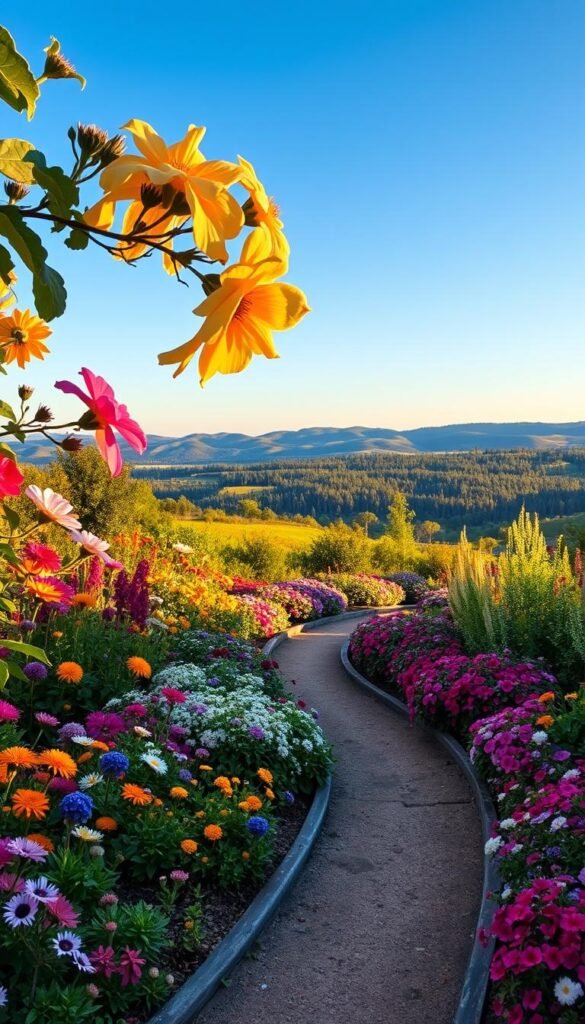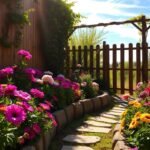Imagine stepping outside every single month to find your outdoor space bursting with life. Strategic planting turns your yard into a living canvas that shifts hues with nature’s rhythm. This approach does more than please the eye – it supports bees, butterflies, and local wildlife while cutting grocery store flower costs.
Successful four-season displays require careful coordination. You’ll combine plants with staggered bloom times, ensuring new colors emerge as others fade. Early crocuses give way to summer phlox before autumn asters take center stage.
The secret lies in mixing plant types that work together like orchestra sections. Hardy perennials form your base, while annuals fill gaps with quick color. Flowering shrubs add structure, and climbing vines create vertical interest. Even culinary herbs like lavender pull double duty with fragrant blooms.
Our guide walks through creating this dynamic display step-by-step. You’ll learn how to:
- Select plants for continuous bloom cycles
- Design beds that transition smoothly between seasons
- Maintain healthy growth through simple care routines
Get ready to transform your space into an ever-changing showcase that delights from first spring buds to winter berry clusters.
Understanding Your Garden Zone and Climate
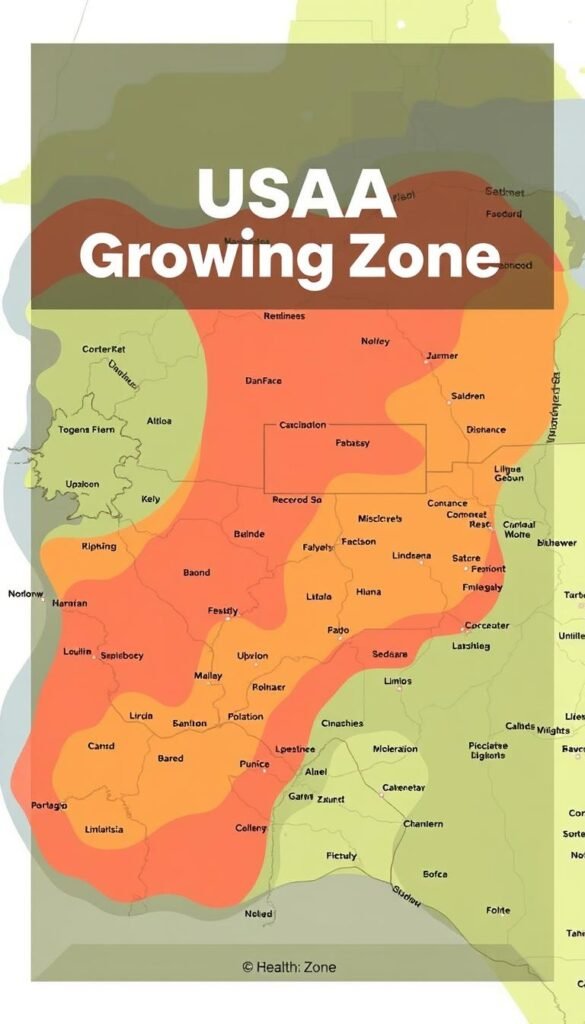
Your location’s climate holds the key to thriving plant life. Knowing your USDA growing zone acts like a roadmap for selecting species that naturally succeed in your area. This simple code (like 5b or 9a) predicts which perennials survive winter and annuals bloom strongest.
Identifying Your USDA Growing Zone
Find your zone in seconds using the USDA’s interactive online map. Zones range from 1 (-60°F winters) to 13 (tropical warmth). This number dictates safe choices: hydrangeas flourish in zones 5-9, while bougainvillea needs zones 9-11.
| Zone Range | Avg Winter Low | Sample Plants |
|---|---|---|
| 3-5 | -40°F to -10°F | Lilacs, Siberian Iris |
| 6-8 | -10°F to 20°F | Camellias, Lavender |
| 9-11 | 20°F to 40°F | Bird of Paradise, Plumeria |
Assessing Local Weather Patterns
Your zone tells half the story. Coastal areas face salt spray, while mountain regions deal with sudden frosts. Track your property’s microclimates – south-facing walls create warm pockets, low spots hold cold air.
Visit nearby botanical gardens to see proven performers. In Phoenix (zone 9b), opt for desert marigolds over peonies. Remember: native species need 70% less water than imports once established.
Evaluating Your Garden Layout and Conditions
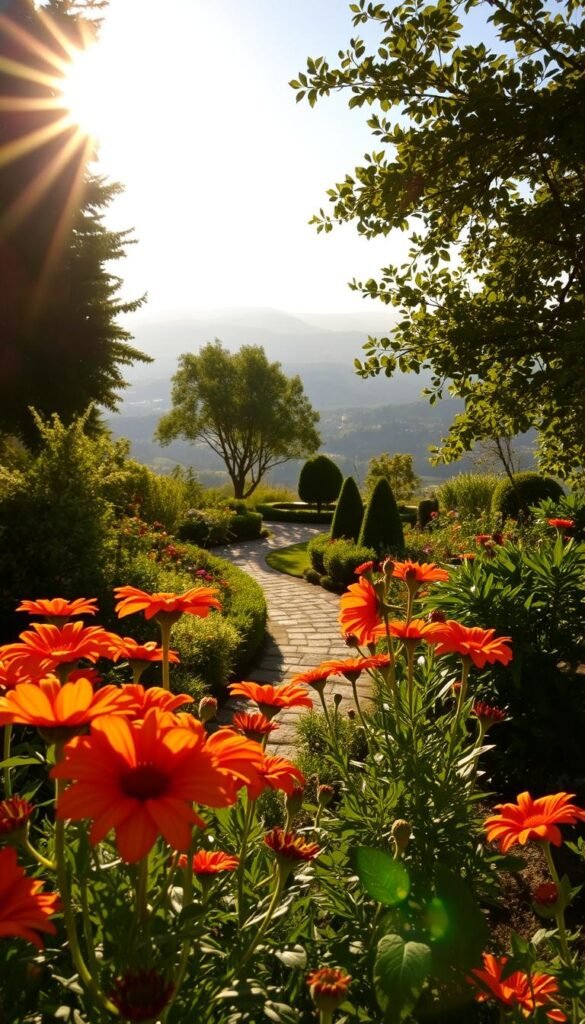
Your outdoor space has unique characteristics that determine plant success. Like matching shoes to terrain, choosing plants that align with your specific conditions ensures healthy growth. Let’s break down the two biggest factors: light patterns and earth composition.
Mapping Light Patterns
Track how sunlight moves across your space through the day. Use free apps like Sun Seeker or simply sketch shadows hourly. Most flowering plants need 6+ hours of direct light – mark these hot zones first.
Shady areas under trees or near walls aren’t wasted. They’re perfect for impatiens or hostas. Watch for reflected light from white fences – it creates bright spots without full sun exposure.
Soil Secrets Revealed
Grab a handful of moist earth. Sandy soil crumbles quickly, while clay forms sticky clumps. Loamy soil holds shape briefly before breaking apart – the gold standard for most plants.
| Soil Type | Drainage Speed | Best Plant Matches |
|---|---|---|
| Sandy | Fast | Lavender, Sedum |
| Loamy | Moderate | Roses, Peonies |
| Clay | Slow | Iris, Daylilies |
Test drainage by digging a 12″ hole and timing how long water takes to disappear. If it pools for hours, consider raised beds. For quick fixes, mix compost into sandy soil or add gypsum to heavy clay.
Don’t forget hidden factors. South-facing slopes warm faster in spring. Low areas collect frost – perfect for cold-hardy pansies. Watch for animal tracks near edible blooms like tulips (deer candy!) and plan defenses early.
Planning Your Year-Round Bloom Strategy
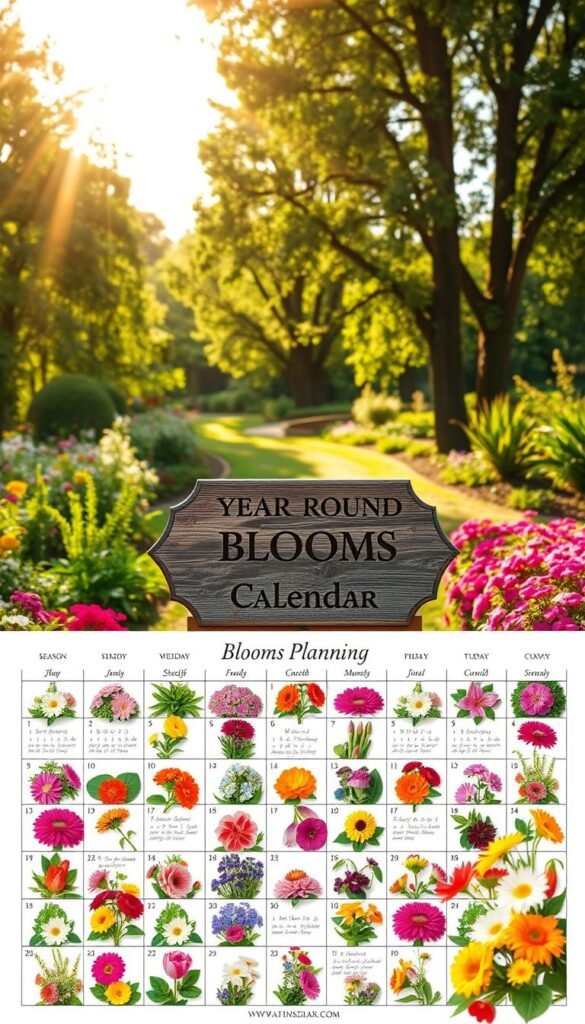
Crafting a nonstop color show requires thinking like a conductor. You’ll orchestrate plants to perform in sequence, creating visual harmony through strategic planning. Start by sketching bloom timelines for potential plants – this reveals hidden gaps in your seasonal lineup.
Pair early risers like bleeding hearts with late stars like asters. Look for varieties offering six-week color runs instead of fleeting shows. Coneflowers and black-eyed Susans work overtime, blooming from midsummer through frost.
Try this simple three-step approach:
- Chart bloom periods using seed packets or nursery tags
- Color-code plants by season on your garden map
- Leave space for quick-grow fillers like zinnias between perennials
Your gardening calendar becomes the ultimate tool. Mark key dates for:
- Spring bulb planting
- Summer deadheading sessions
- Fall division of overgrown clumps
Smart planners stagger plantings every two weeks. This trick extends peony season and prevents all your cosmos from peaking simultaneously. Remember: overlapping bloom phases create nature’s version of a relay race – petals keep passing the baton!
Flower Garden Plans for Each Season: Rotating Blooms and Keeping Beds Vibrant
Transform your outdoor space into a year-round spectacle with smart plant rotations. By pairing early bloomers with late performers, you’ll craft a landscape that never sleeps. This method turns empty winter beds into textured wonderlands, using seed heads and evergreen foliage as natural decorations.
Think beyond petals. Ornamental grasses add movement in fall, while red-twig dogwood branches pop against snow. A well-placed bench or stone path keeps eyes engaged even when blooms fade. As landscape designer Lauren Springer notes: “Winter interest isn’t an afterthought – it’s the foundation of great garden design.”
Try this seasonal framework:
| Season | Color Stars | Structure Plants |
|---|---|---|
| Spring | Tulips, Dianthus | Boxwood, Juniper |
| Summer | Sunflowers, Zinnias | Arborvitae, Lavender |
| Fall | Mums, Sedum | Smokebush, Holly |
| Winter | Hellebores | Birch Trees, Red Osier |
Small spaces shine too. Pair compact evergreens with colorful container gardening flowers that swap with the seasons. This approach feeds pollinators year-round – winter berries sustain birds, while summer blooms host butterflies.
Track what works in a journal. Note which combinations create smooth transitions between seasons. Over time, you’ll develop a self-renewing display that surprises and delights with every weather shift.
Incorporating a Diverse Mix of Flower Types
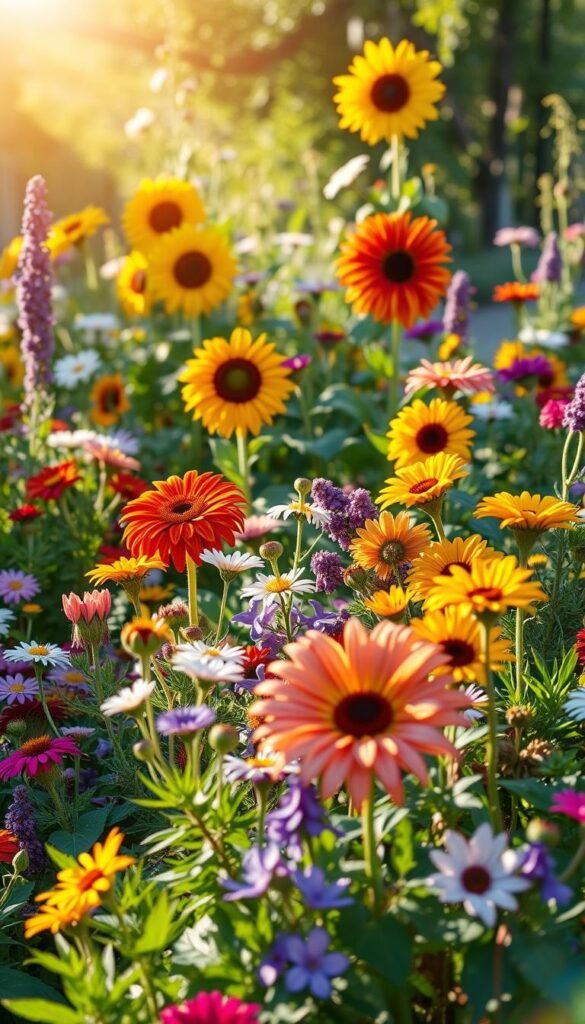
A thriving landscape thrives on variety. Combining different growth habits and life cycles creates natural layers of color and texture. This living tapestry evolves daily, offering fresh discoveries with each visit.
Nature’s Team Players
Perennials form your garden’s foundation. Plants like coneflowers and hostas return yearly, saving time and money. They establish deep roots that protect soil during heavy rains.
Annuals bring instant impact. Petunias and marigolds explode with color in containers or bare spots. Many drop seeds for surprise volunteers next season – nature’s free gifts!
Spring bulbs work magic underground. Daffodils push through frost, while alliums add summer fireworks. Pair early tulips with late-blooming peonies for seamless transitions.
Flowering shrubs anchor designs. Hydrangeas offer months of blooms, while elderberries feed birds. Their woody stems create winter silhouettes when perennials sleep.
| Plant Type | Key Benefit | Sample Varieties |
|---|---|---|
| Vines | Vertical accents | Clematis, Honeysuckle |
| Herbs | Edible blooms | Lavender, Borage |
| Grasses | Movement | Fountain Grass, Muhly |
Edible flowers like nasturtiums spice up salads while brightening beds. As horticulturist David Culp advises: “Let plants multitask – beauty should work for its keep.” This mix creates habitats for beneficial insects while keeping your view constantly fresh.
Designing for Continuous Seasonal Interest
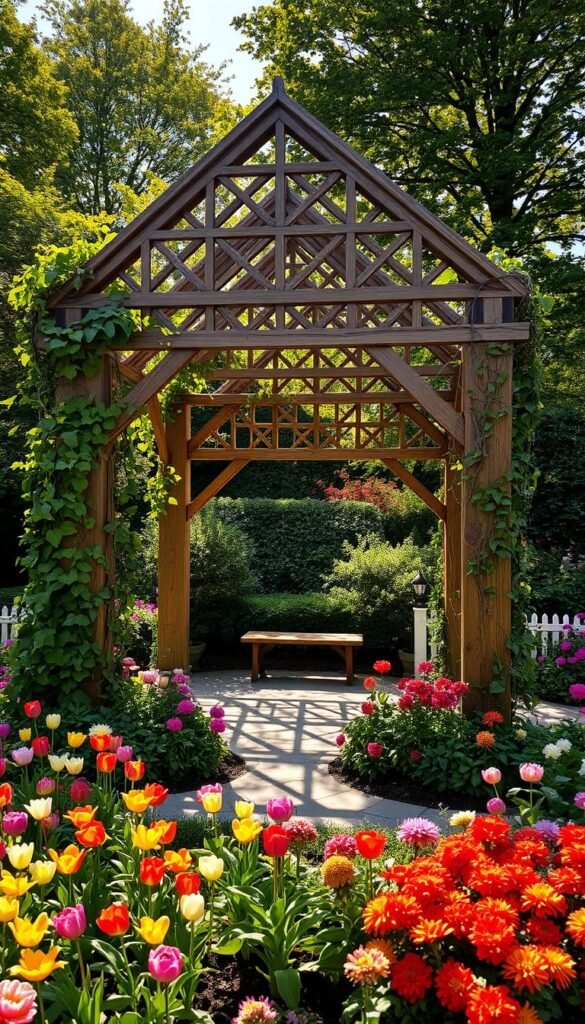
True artistry in landscaping shows through every season. While summer’s blooms demand attention, thoughtful design ensures your space remains captivating even in dormancy. Evergreens act as nature’s scaffolding, holding visual interest when other plants retreat.
Start with structural plants that shape your space. ‘Sky Pencil’ holly adds dramatic vertical lines, while ‘Hudsonia’ balsam fir offers feathery texture. These anchors maintain form as deciduous neighbors shed leaves. “Structure plants are the silent conductors of your garden’s symphony,” notes landscape expert Lauren Springer.
Winter reveals hidden beauty. Seek plants with:
- Peeling bark like paperbark maple
- Persistent berries on winterberry holly
- Architectural seed heads from coneflowers
| Structural Plant | Key Feature | Seasonal Highlight |
|---|---|---|
| ‘Sky Pencil’ Holly | Vertical form | Winter silhouette |
| Red-Twig Dogwood | Crimson stems | Snow contrast |
| Ornamental Grasses | Movement | Fall/winter texture |
| ‘Hudsonia’ Balsam Fir | Soft needles | Year-round green |
Layer textures for depth – pair glossy magnolia leaves with fuzzy lamb’s ear. Create sight lines using focal points like sculptural benches or bubbling fountains that work in all weather. For more year-round garden design principles, explore our curated resources.
Balance is key. Let flowering perennials shine in warmer months while evergreens whisper subtle beauty in cold seasons. This approach keeps your space feeling intentional through nature’s constant changes.
Scheduling Planting and Maintenance Throughout the Year
Your green thumb needs a roadmap. A well-planned schedule transforms chaotic tasks into smooth routines, ensuring your space thrives throughout the year. Start by marking key dates for soil prep, pruning, and protection measures tailored to your climate.
Building Your Seasonal Blueprint
Begin with frost dates – these anchor your planting calendar. Track seed-starting windows for tomatoes (6-8 weeks before last frost) and cold-hardy greens (direct sow 4 weeks earlier). Use color-coded sticky notes or digital apps to visualize overlapping tasks.
Smart timing maximizes results. Prune spring bloomers like lilacs after flowers fade but before July. Deadhead summer perennials weekly to prolong shows. As horticulturist Janet Macunovich advises: “Plants don’t wear watches – they respond to consistent care.”
| Season | Critical Tasks | Optimal Timing |
|---|---|---|
| Spring | Soil amendment | 2 weeks before planting |
| Summer | Pest monitoring | Weekly inspections |
| Fall | Bulb planting | 6 weeks before frost |
| Winter | Tool maintenance | January downtime |
Adapt as nature shifts. If spring arrives early, move up transplanting by 10 days. Keep a journal noting bloom peaks and pest outbreaks – these patterns guide future steps. Order next year’s seeds during winter sales while selections are fresh.
Group similar tasks together. Dedicate March weekends to pruning, May mornings to planting. This rhythm reduces overwhelm while ensuring each plant gets attention when it matters most. Remember: successful spaces grow from thoughtful planning, not chance.
Maximizing Space with Container Gardening and Raised Beds
Urban dwellers often unlock vibrant displays through portable gardens. When ground space shrinks or soil quality falters, containers become your perfect solution. These movable planters let you chase sunlight across patios or create instant focal points near entryways.
Raised beds offer similar flexibility with better root control. Build them tall for easier access or layer plants vertically – strawberries under tomato vines, herbs edging flower borders. You’ll dodge poor drainage issues while extending your growing season.
Mix edible and ornamental varieties for double-duty beauty. Basil pairs beautifully with petunias, while dwarf fruit trees thrive in half-barrel planters. Rotate pots seasonally – spring tulips make way for summer geraniums, then fall mums.
Vertical space multiplies your options. Hang fuchsia baskets from pergolas or train clematis up balcony rails. Even fire escapes can host compact succulents in wall-mounted pockets. Every inch becomes potential real estate when you think upward.
Remember: quality potting mix prevents compaction in containers. For raised beds, blend compost with native soil. This approach gives plants room to breathe while letting you curate displays that adapt as your needs evolve.

